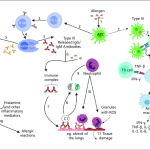The response of the host to the presence of foreign substances can trigger four types of hypersensitivity reactions:
I. Immediate
II. Cytotoxic
III. Immune complex
IV. Cell-mediated
Type I: Immediate Hypersensitivity (Anaphylactic Reaction)
These allergic reactions are systemic or localized, as in allergic dermatitis (e.g., hives, wheal and erythema reactions). The reaction is the result of an antigen cross-linking with membrane-bound IgE antibody of a mast cell or basophil. Histamine, serotonin, bradykinin, and lipid mediators (e.g., platelet activating factor, prostaglandins, and leukotrienes) are released during the anaphylactic reaction. These released substances have the potential to cause tissue damage.
Type II: Cytotoxic Reaction (Antibody-dependent)
In a cytotoxic reaction, the antibody reacts directly with the antigen that is bound to the cell membrane to induce cell lysis through complement activation. These antigens may be intrinsic or “self” as in autoimmune reactions or extrinsic or “non-self.” Cytotoxic reactions are mediated by IgG and IgM. Examples of cytotoxic reaction are the Rh incompatibility of a newborn, blood transfusion reactions, and autoimmune diseases like Pemphigus Vulgaris, Bullous Pemphigoid, autoimmune hemolytic anemia and Goodpasture’s syndrome to name a few.
Type III: Immune Complex Reaction
IgG and IgM bind antigen, forming antigen-antibody (immune) complexes. These activate complement, which results in PMN chemotaxis and activation. PMNs then release tissue damaging enzymes. Tissue damage present in autoimmune diseases (e.g., systemic lupus erythematosus), and chronic infectious diseases (e.g., leprosy) can be attributed, in part, to immune complex reactions.
Type IV: Cell-Mediated (Delayed Hypersensitivity)
Cell-mediated reactions are initiated by T-lymphocytes and mediated by effector T-cells and macrophages. This response involves the interaction of antigens with the surface of lymphocytes. Sensitized lymphocytes can produce cytokines, which are biologically active substances that affect the functions of other cells. This type of reaction takes 48-72 hours, or longer, after contact with the antigen to fully develop. Many chronic infectious diseases, including tuberculosis and fungal infections, exhibit delayed hypersensitivity.
Evidence suggests that hypersensitivity reactions, particularly Type III and IV, may be involved in the pathogenesis of periodontal disease.


